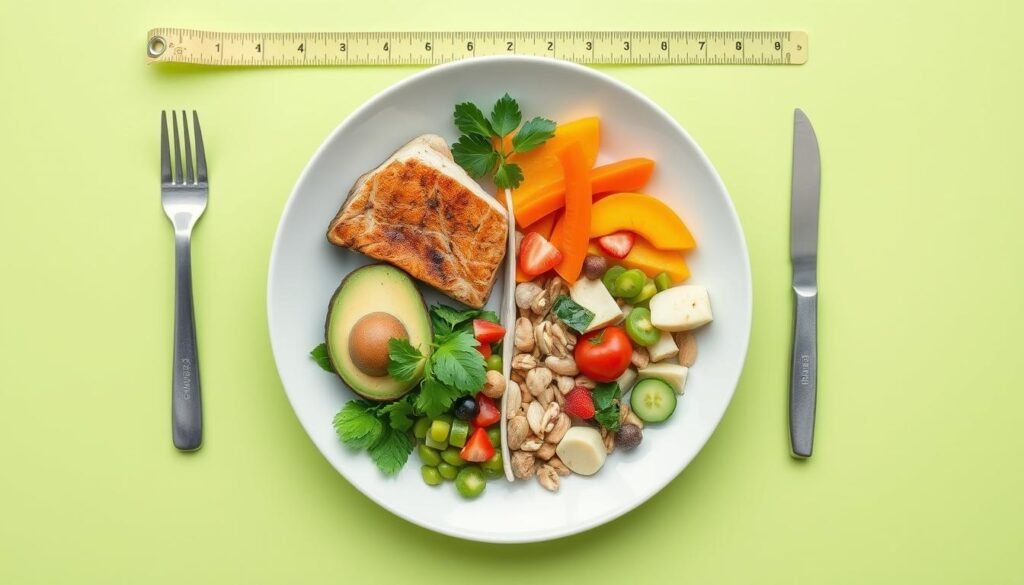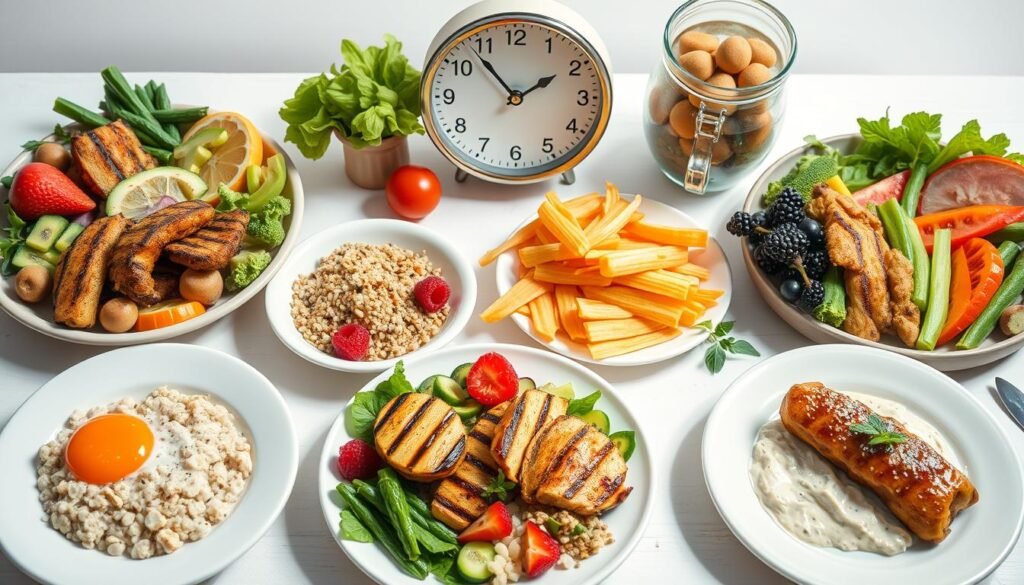Did you know it’s common to gain 1 to 2 pounds of fat weekly during bulking? This fact shows the difficulty athletes face when they shift from bulking to cutting. Knowing how to cut fat after bulking is key for those who want to keep their muscle and lose the extra fat. This guide will show you how to create a good plan. It involves eating fewer calories and following a strong workout routine.
Cutting doesn’t mean you have to starve. It’s about smart eating and working out. Things like when you eat, what nutrients you focus on, and how hard you exercise are vital. By keeping an eye on these factors, you can move through the cutting phase while keeping your energy and muscles.
Key Takeaways
- Cutting after bulking involves a careful reduction of calories while preserving muscle mass.
- Maintaining a protein intake above 1.2 grams per kilogram of body weight is vital during a cut.
- A gradual caloric deficit of 500-1000 calories per day can lead to safe fat loss.
- Incorporating balanced macronutrient ratios—ideally 40% protein, 30% carbohydrates, and 30% fats—is crucial.
- High-intensity workouts, including HIIT, can significantly aid fat loss during the cutting phase.
- Meal timing, especially carbohydrate intake around workouts, plays a critical role in fat burning.
- Monitoring progress and making adjustments are key to successful fat loss and muscle retention.
Understanding the Cutting Process
Moving from bulking to cutting is key in reaching your fitness goals. The cutting phase aims to lower body fat while keeping muscle. It’s different from the bulking phase, which boosts calorie intake to gain muscle. Good cutting strategies require eating fewer calories but focusing on nutritious foods to aid performance and healing.
What Does Cutting Mean?
Cutting means purposefully losing body fat by eating 20-25% fewer calories. This method uses stored fat for energy, preserving muscle. To cut fat after bulking, high protein is vital. It helps keep muscle during a calorie deficit. Protein shakes can help meet the daily protein need of 1 to 1.4 grams per pound.
Why Do Athletes Bulk and Cut?
Athletes bulk to get more muscle mass, setting them up for cutting to define those muscles. They follow a cycle of bulking and cutting for muscle growth and fat loss. This approach improves both looks and performance. For successful cutting, mixing strength training with cardio keeps metabolism high. It’s important to stick to a diet and exercise plan.
Setting a Caloric Deficit for Fat Loss
Starting with a caloric deficit is key for losing fat effectively. It’s important to know how many calories you need each day. This way, you can eat less than what your body uses. Adjusting how much you eat helps burn extra fat and leads to lasting weight loss.
How to Calculate Your Daily Caloric Needs
To figure out your daily calorie needs, start with the Harris-Benedict formula. This determines your Basal Metabolic Rate (BMR). For men, use this equation:
BMR = 66 + (6.2 x weight in lbs) + (12.7 x height in inches) – (6.8 x age)
The formula for women is slightly different:
BMR = 655 + (4.4 x weight in lbs) + (4.6 x height in inches) – (4.7 x age)
After finding your BMR, multiply it by how active you are to get your Total Daily Energy Expenditure (TDEE). Here are the levels:
- Sedentary: BMR x 1.15
- Mostly sedentary: BMR x 1.35
- Lightly active: BMR x 1.55
- Highly active: BMR x 1.75
Aim for a caloric deficit of 500 to 750 calories a day. This approach helps lose fat safely while keeping your muscles strong.
Gradual Caloric Reduction: The 500-Calorie Rule
Cutting down 500 calories daily is a smart move for losing fat. This strategy leads to losing about 1 pound each week. It’s a steady and safe way to slim down. Avoid large calorie cuts to prevent muscle loss and a slower metabolism.
Making healthy food choices is vital. Pair this with weight training and cardio exercises. Focusing on what you eat and staying active boosts health and maintains muscles while losing fat.
Effective Fat Cutting Strategies
To effectively cut fat, mix the right food and exercise. This mix helps you lose fat but keep muscle. A good diet gives your body the nutrients it needs. With the right fat cutting strategies, you can tackle this tough phase well.
Importance of a Balanced Diet During Cutting
Eating right is key when cutting fat. Aim for 20-25% fewer calories than your usual intake to lose fat. Tracking your food is a must. It makes sure you eat enough protein. Eating lots of protein helps keep muscle while you’re eating less.
Studies show eating more protein keeps muscle during cutting. This is vital for those actively reducing their calorie intake.
High-Intensity Workouts for Maximum Fat Loss
High-Intensity Interval Training (HIIT) is great for losing fat. These workouts burn lots of calories and help keep muscle. Keep doing strength training too. It boosts your metabolism even after your workout.
Add cardio 2-4 times weekly, for 20-40 minutes, to help lose fat. It helps stay in the calorie deficit needed for fat loss.
Proper diet and intense workouts lead to great results. For tips on how to change your diet while cutting, visit this guide.
Your Ideal Macronutrient Ratios
Knowing your ideal macronutrient mix is key for losing fat and keeping muscle while cutting. It helps you stay energetic and well-nourished. Most experts suggest a mix of about 40% carbs, 40% protein, and 20% fats. This mix supports your energy needs and is vital for keeping muscle, especially through protein.
Balancing Carbs, Proteins, and Fats
When you’re trying to trim fat, it’s important to find the right mix of carbs, protein, and fats. Carbs are your main energy source. Protein is essential for repairing and building muscle. Fats are needed for hormone balance and health. You should get at least 0.5 g/lb of your body weight in carbs daily to power your workouts.
| Macronutrient | Recommended Intake | Percentage of Total Calories |
|---|---|---|
| Protein | 1.0–1.2 g/lb | 40% |
| Carbohydrates | 0.5 g/lb (minimum) | 40% |
| Fats | 15–25% of total calorie intake | 20% |
The Role of Protein in Maintaining Muscle Mass
Protein is very important in your diet during a cut. It keeps muscles strong, even when you’re eating less. Those focusing on cutting should eat 1.0 to 1.2 g/lb of body weight in protein. This helps muscles recover well and stops them from breaking down. Given protein has 4 calories per gram, planning your daily protein is crucial.

How to Cut Fat After Bulking
Knowing when to start cutting is about reaching your muscle goals and looking at your progress. You must watch your calories closely during this time. To lose the extra bulking weight, eat 20-25% less calories than usual. Adding strength training helps keep your muscles strong and boosts your metabolism.
When to Start the Cutting Phase
Be sure your bulk phase achieved what you wanted before you start cutting. Keep an eye on your progress to know when to begin. It’s wise to wait two weeks after bulking to change your calories. This waiting time lets your body stabilize and shows real trends in weight loss. If you’re not losing weight after this, reduce your calories by 250 a day to see changes.
Types of Foods to Include in Your Diet
The food you eat is key to losing fat after bulking. Choose whole foods that are not heavily processed. These foods will keep you healthy during this phase. Make sure to:
- Lean Proteins: Eat chicken, fish, legumes, and quality protein powders. They should have at least 20 grams of protein per scoop.
- Complex Carbohydrates: Eat foods like potatoes, whole grains, and oats. They are great for energy, especially when you work out.
- Healthy Fats: Use avocados, nuts, and olive oil. But remember, carbs to fats should be about 2:1.
Keeping up with protein is important. Research shows it helps keep muscle even when you are eating less. Try to eat a lot of protein, especially when you’re lifting weights regularly. This will help you lose fat the right way and stay healthy.
Incorporating Cardio into Your Routine
Adding cardio to your cutting routine helps burn fat while keeping muscle. It boosts how many calories you burn. This is great especially after bulking up.
Benefits of Steady-State vs. HIIT Workouts
Steady-state and HIIT workouts both have their perks. Light jogging or cycling, being steady-state, helps with fat loss over a longer time. HIIT, on the other hand, burns fat quickly without losing muscle. Using both methods can give the best results in your cut.
Recommended Cardio Frequency and Duration
To lose fat effectively, try doing 30 minutes of cardio most days. Mix low and high-intensity sessions to match your fitness level. For instance, mix 1 to 2 HIIT sessions a week with steady cardio. But, keep your cardio time to at most half of your weightlifting time. If you weightlift for six hours a week, cap cardio at three hours.
Blending cardio with strength training is key to a successful cut. Good cardio routines enhance muscle recovery by improving blood flow. Skipping cardio can reduce cardio health, making it tough to get back to routine.
Moderate cardio, like swimming or using an elliptical, is smart during a cut. Such activities are easy on the joints and complement your overall fitness plan.
Keep Lifting: Strength Training During Your Cut
It’s key to keep strength training when you’re cutting to hold onto muscle. When you cut calories, you need to tweak your workout. Keep up the volume and intensity, so your muscles stay active and grow, even when you’re losing fat.
How to Adjust Your Lifting Routine
Here’s what to do to change your workout while cutting:
- Stick with heavy lifting: Lifting heavy is best for keeping muscle mass.
- Keep workouts intense: Aim for a seven out of ten in intensity for the best results.
- Cut back on challenging sets: This helps keep your volume right while eating less.
- Work each muscle group twice a week: This is what experts suggest to keep muscles active.
Importance of Maintaining Volume and Intensity
You don’t need as much volume as before to keep muscle. Here are important points:
- Getting enough protein helps balance muscle loss and upkeep. You need at least 1.8g per kg of your weight.
- Bodybuilders may need a slower cut. A faster cut works for general fat loss.
- Try drop sets and supersets to make your strength training more effective.
To sum it up, strength training is a must during a cut. Changing your routine to focus on intensity and the right amount of volume will help you keep muscle while losing fat.
Meal Timing: Optimizing Nutrient Intake
Understanding when and what to eat is key for muscle and fat management. It’s about meal timing to boost energy and metabolism. This ensures nutrients are well absorbed.
Carb Timing Around Workouts
Carb timing is vital, especially before and after workouts. Eating carbs before can improve your energy for better performance. It’s good to have a 400-calorie carb meal before aerobic exercises.
Keeping up your glycogen helps with endurance and recovery. For muscle repair, take whey protein and some carbs 30–60 minutes after working out. A mix of carbohydrates and protein boosts fat burn after exercising.
How to Spread Your Meals Throughout the Day
Spacing out meals keeps your energy steady and makes nutrients work better. If cutting, aim for 2-3 meals a day. For bulking, 3-4 meals help. Eating two meals should have a 7-9 hour gap.
More than two meals don’t always mean more muscle maintenance. Athletes might need more frequent meals for their energy needs. Spread protein intake every 3 to 5 hours to support muscle building. Eating too often or too little can affect muscle growth and mass.

Supplements That Can Aid in Fat Loss
Adding supplements to your diet can help you lose fat. These aids boost health and improve your workout recovery. Consider using branched-chain amino acids (BCAAs) and various proteins. They help keep muscles strong and provide energy when you’re eating less.
The Role of BCAAs in Muscle Preservation
BCAAs are crucial for athletes on a diet. They help your body burn fat for energy, which is great when you’re trying to slim down. BCAAs also keep muscle protein building up, even when you’re eating less. This means you won’t lose muscle.
Experts recommend taking 5-15 grams of BCAAs every day. This not only helps prevent muscle loss but also speeds up recovery. That way, you can keep up with your workouts.
Using Protein Supplements Effectively
Protein supplements like whey protein isolate help meet daily protein needs. You should have 1 gram of protein for each pound you weigh. Taking 20-40 grams of whey protein isolate once or twice a day helps keep muscles strong during weight loss.
Eating the right proteins can also help your body use insulin better. This is good for your metabolism. Adding greens powders and omega-3 supplements can up your nutrient intake and lessen cravings. This all helps with losing fat.
| Supplement | Recommended Dosage | Benefits |
|---|---|---|
| Branched-Chain Amino Acids (BCAAs) | 5-15 grams | Muscle preservation, recovery enhancement |
| Whey Protein Isolate | 20-40 grams, 1-2 times/day | Muscle maintenance, aids in protein intake |
| L-Carnitine | 1-3 grams | Improves fat transport, energy utilization |
| Omega-3 Fatty Acids | Varies (ensure a balanced intake) | Enhanced insulin sensitivity, metabolic support |
| Grains of Paradise | Varies | Activates brown fat cells, aids calorie burning |
| Green Tea Extract | Varies (optimal dosage preferred) | Increases daily calorie burn, antioxidant properties |
Monitoring Progress and Making Adjustments
Focusing on individual progress is a key element during a cutting phase. It allows for effective tracking of fat loss. This ensures alignment with fitness goals. A variety of methods can be used to accurately assess fat loss. Each method offers insights that help make needed adjustments.
How to Track Your Fat Loss Journey
Keeping a food diary is a top strategy. It involves noting daily calorie intake and macronutrient distribution. This helps one better understand their eating habits. Taking regular measurements, like waist size and weight, provides data to track loss over time.
Progress photos also provide a visual of changes. This approach aids informed decisions about diet and exercise adjustments.
Recognizing When to Adjust Your Plan
Being aware of certain signs is crucial. If weight loss slows or stops, it may mean it’s time to re-evaluate. Looking at workout energy, hunger signs, and measurements helps judge effectiveness.
If results aren’t as expected, adjusting the diet and exercise plan may be needed. This could mean changing calorie intake or workouts. Monitoring progress helps make precise changes for consistent fat loss.

Conclusion
Learning how to cut fat after bulking is key for anyone with fitness goals. It involves eating 500 to 750 calories less a day while keeping protein high. This means getting 1 to 1.5 grams of protein per pound of body weight. It helps keep the muscle you worked hard for.
Adding both strength training and cardio helps burn fat faster. You should aim for 150-300 minutes of cardio each week. Also, lifting weights helps keep your muscles strong. Be sure to track your progress with weights and body measurements. Then, you can change your plan as needed.
The cutting phase can last 4 to 16 weeks, based on your goals and how you’re doing. By sticking to a good plan that includes diet, exercise, and enough sleep, you can get through the cutting phase well. Aim for 7 to 9 hours of sleep each night. This way, anyone can successfully cut fat and feel confident about their results.